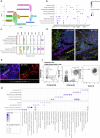Molecular and spatial analysis of tertiary lymphoid structures in Sjogren's syndrome
- PMID: 39747819
- PMCID: PMC11697438
- DOI: 10.1038/s41467-024-54686-0
Molecular and spatial analysis of tertiary lymphoid structures in Sjogren's syndrome
Abstract
Tertiary lymphoid structures play important roles in autoimmune and non-autoimmune conditions. While many of the molecular mechanisms involved in tertiary lymphoid structure formation have been identified, the cellular sources and temporal and spatial relationship remain unknown. Here we use combine single-cell RNA-sequencing, spatial transcriptomics and proteomics of minor salivary glands of patients with Sjogren's disease and Sicca Syndrome, with ex-vivo functional studies to construct a cellular and spatial map of key components involved in the formation and function of tertiary lymphoid structures. We confirm the presence of a fibroblast cell state and identify a pericyte/mural cell state with potential immunological functions. The identification of cellular properties associated with these structures and the molecular and functional interactions identified by this analysis may provide key therapeutic cues for tertiary lymphoid structures associated conditions in autoimmunity and cancer.
© 2024. The Author(s).
Conflict of interest statement
Competing interests: F.B. is an employee of Candel Therapeutics. C.D.B is the founder of Mestag Therapeutics. B.A.F. has undertaken consultancy for: Novartis, BMS, Servier, Galapagos, Roche, UCB, Sanofi, Janssen, A.Z., Otsuka, Amgen, Kiniksa and received research funding from Janssen, Servier, Galapagos, and Celgene. A.F. has consulted for Janssen and Sonoma, and has received research funding from: BMS, Roche, UCB, Nascient, Mestag, GSK, and Janssen. S.J.B. has undertaken consultancy for: Abbvie, Amgen, Argenx, Aurinia, Bain, BMS, EcoR1, Iqvia, J&J/Janssen, Kiniksa & Novartis. K.G.L. and A.P.F. are employees of F. Hoffmann-La Roche Ltd. The remaining authors declare no competing interests.
Figures






References
-
- Petitprez, F. et al. B cells are associated with survival and immunotherapy response in sarcoma. Nature577, 556–560 (2020). - PubMed
-
- Huibers, M. M. et al. The composition of ectopic lymphoid structures suggests involvement of a local immune response in cardiac allograft vasculopathy. J. Heart Lung Transpl.34, 734–745 (2015). - PubMed
Publication types
MeSH terms
Associated data
- Actions
- Actions
Grants and funding
LinkOut - more resources
Full Text Sources
Medical
Molecular Biology Databases

